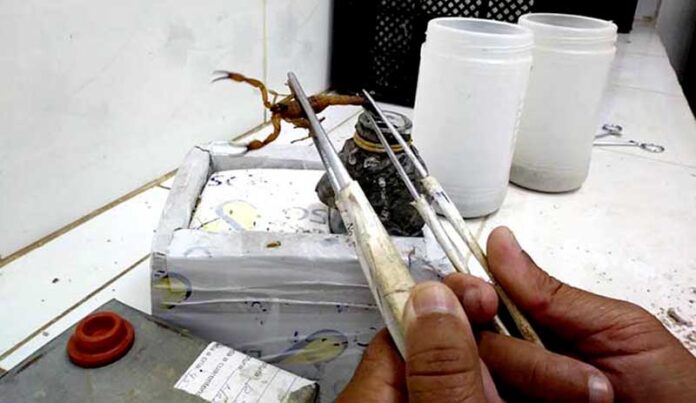 The scorpion, as it is commonly known, is reproduced in captivity for the extraction of the venom toxin. |
Specialists of the Biological and Pharmaceutical Laboratories Business Group (LABIOFAM, in Spanish) in Las Tunas are working on the study and conservation of scorpion populations in the northern region of the province and the municipality of Jobabo.
Las Tunas, Cuba.- The research, which is being carried out in conjunction with the Eastern Centre for Ecosystems and Biodiversity (Bioeco in Spanish) in Santiago de Cuba, aims to detect the specific areas with the greatest number of arachnids and to focus actions there to prevent indiscriminate hunting and the improper use of their toxins for health treatments.
José Ángel Martínez Hernández, executive director of Production, Business, Quality, and Development of Labiofam, said in exclusive statements to the Cuban News Agency that the mapping of the habitat of these animals showed the largest population in the coastal area of the municipality of Manatí, in the north of Las Tunas, with other less populated areas in the interior and south.
"We visited a group of hunters and held conversations to raise awareness of the long-term impact that the decline of the scorpions will have, as they form part of a trophic chain with insects and pests in their diet, so their loss would be severely sensitive for the fauna," Martínez Hernández pointed out.
Among the preventive measures to avoid extinction, the specialist added, is the formulation of a payment system for hunters to include them in the company's human resources, and thus ensure that the activity is safe and based on the care of each specimen that is extracted from the environment.
The scorpion, as it is commonly known, is reproduced in captivity for the extraction of the venom toxin as an active ingredient, to improve the quality of life of patients with cancer or other diseases with inflammatory effects.
Among the entity's productions is the manufacture of the homeopathic product Vidatox, based on these toxins, so that each year between 400 and 600 specimens are extracted from the environment; however, Labiofam releases more than 14,000, after approximately 24 months in incubation.
The results of the study will also make it possible to define the behavior of the scorpions once they return to their natural habitat, their performance and levels of health, and, above all, whether or not these areas grow, to search for ways to guarantee higher yields.